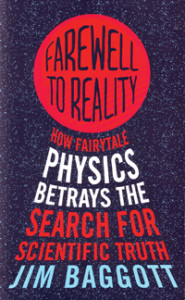Farewell to Reality
How Fairytale Physics Betrays the Search for Scientific Truth
by Jim Baggott. Published by Constable www.constablerobinson.com
“Can you design an experiment to prove the existence of angels?” asked a friend of mine during a recent theological discussion. ‘No’ is the obvious answer but then I started thinking about it a bit more. I have no working hypothesis of the mechanisms of angels but I could spend a few decades imagining how they might work if they did exist. And then… Well then I’d be in the same position Jim Baggott thinks physicists are with String Theory.
“Farewell to Reality” is broken into two sections and while it covers some of the same ground as Lee Smolin’s “The Trouble with Physics” it does so without Smolin’s faint air of ‘damn-string-theorists-get-all-the-best-jobs’ petulance. The first section is an overview of current physics’ ‘Standard Model’ with a crash course in relativity (the description of time dilation is especially clear and snappy), frame dragging, the difference between fermions and bosons, Quarks, Casmir force etc. Now, you could stack physics books floor to ceiling and still just be scratching the surface of the subject but if it has anything to do with physics or cosmology, Baggott gives it at least a name-check here. The problem with the Standard Model is that while it’s solid as far as it goes, it doesn’t go far enough. It says nothing about why the particles and forces have the masses and energies they do and it’s silent on the Dark Matter and Dark Energy that comprise 96% of the Universe. The Standard Model tells us almost everything about almost nothing.
In the second part we enter the wilder realms of physics speculation – the ‘here be dragons’ territory that scientists have quested into looking for new physics beyond the Standard Model. Over here we have Branes, there Calabi-Yau manifolds, beyond them holographic reality and multiple universes and, of course, Supersymmetry with its Squarks, Higgsionos and Winos (don’t laugh, you’re paying for this) along with the theory it underpins known as String Theory.
Ever since Leonard Susskind’s unloved, left field idea about vibrating strings burst from obscurity to the theory du jour in the 80’s, String Theorists have been elaborating the mathematics behind the basic idea. So much so in fact that there are 10 to the power of 500 possible interpretations. Edward Witten (you may not have heard of him but a lot of the smartest people on the planet think he’s the smartest person on the planet) proposed ‘M Theory’ to corral all the various String Theories under one mathematical roof. Well, not so much a theory really as a bunch of suggestions as to what such a theory should contain. Really just speculation that such a theory could exist.
For Baggott, this is the main problem. All of these exciting, headline grabbing ideas are really just that; speculation based on assumptions based on unproven mathematics with almost no experimental or observational evidence. While physicists love String Theory for its beauty, elegance and ‘tightness’, it has not managed to produce a single prediction in 30 years. There’s no ‘E=MC2’ eureka moments here. “This all seems rather mad” says Baggott at one point (which I couldn’t help but hear in Father Dougal’s voice) but so what? Why the hate?
Richard Feynman defined the process of science as ‘guess-predict-observe’. But if this is what science is then String Theory isn’t science – there’s no ‘predict’ and certainly no ‘observe’. Some of the “lost generation” of physicists who’ve spend a career only on String Theory are pushing for a new interpretation; if what they do isn’t science, then re-define science as what they do. The problem with that, as Baggott stresses, is that last step, the litmus test of checking your ideas against reality, is the only thing that stands in the way of humanity’s endless capacity to fool ourselves. Without that (however unpalatable) step there’s nothing to separate science from pseudo-science, theory from theology or physics from fairytale.
